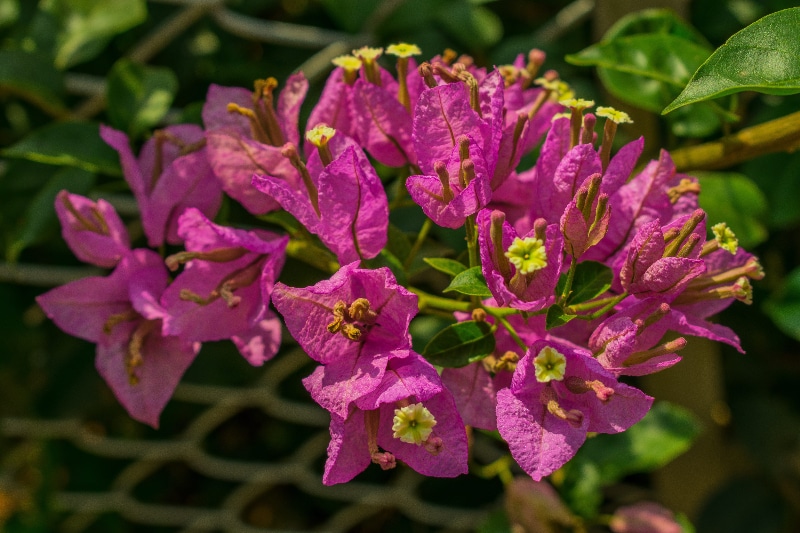You can simplify the process into four steps to know how to root bougainvillea cuttings. This tropical vining shrub will undoubtedly make your garden stand out, and it doesn’t even require much effort to grow. And if you know how to start bougainvillea from cuttings, you can produce exact copies of your favorite plants.
While bougainvillea will tolerate challenging conditions, remember that you must provide the cuttings’ optimal environment to grow roots. This is easier to achieve in the greenhouse because you have control over different factors indoors. This is why starting plants indoors will put you at a headstart on developing roots.

How To Grow Bougainvillea From Cuttings
Step #1. Collection
The first step for rooting bougainvillea from cuttings is collecting the cuttings themselves. Wear gloves and be mindful in protecting your eyes when handling bougainvillea. It would also be best to mark your calendar from the end of spring to the middle of summer to take the cuttings when the plants are actively growing.
One can assume that this is a crucial step because the cuttings you must take should be healthy. Therefore, the parent bougainvillea for the cuttings should also be in optimal condition. If your area is challenging for bougainvillea, you can consider growing them in the greenhouse instead.
This way, you can select cuttings without worrying about stressing the parent plants. Choose a disease-free stem section with around seven nodes to ensure a healthy bougainvillea later on. And compared to other plants, you want to use hardwood or semi-ripe stems instead of the younger green ones for optimal rooting.
Step #2. Preparation
Use sharp and sterile shears to cut a section around six inches, but don’t be afraid to cut back the plant to have more cuttings to use. A useful tip to remember is cutting the lower end at a 45-degree angle because this will help in rooting. Remember that the larger the surface area of the end, the easier it will be for the plant to take water and nutrients, crucial for root development.
Before planting, don’t forget to remove all leaves, flowers, and offshoots so that they won’t compete with root development. You also want to ensure that you’ll only be left with the woody shaft and no green sections. You have the option to store the cuttings for one to two weeks in the refrigerator or use them for rooting immediately.
If you plan on growing the cuttings, you can dip the end in rooting hormone to encourage faster root development. Some gardeners even make their own rooting ingredients made from everyday household items. Otherwise, keep your cuttings from drying out by wrapping them in damp paper towels and placing them in an airtight plastic bag for storing in the refrigerator.
Step #3. Rooting
You can root the cuttings in the greenhouse inside containers with a moist growing medium. You can also mix potting soil, sand, and compost for growing bougainvillea. The bottom line is that it should be well-draining to avoid rot as the cutting grows root.
Stick the cutting into the medium so that it stands upright. You can also plant at an angle, so the nodes are in contact with the medium. To avoid overcrowding, allocate one cutting per pot as well.
After planting, water your cuttings thoroughly, so the medium is moist. This will be supportive of rooting, but you also don’t want to create a wet environment. Use a well-draining container as well to avoid standing water.
Step #4. Maintenance
As previously mentioned, you don’t want to overwater the cuttings because they can damage the roots. More so, a wet environment can encourage fungal diseases that will indeed inhibit rooting. Instead, always check the medium when maintaining moisture.
Similar to other plants, your bougainvillea cuttings will also benefit in a humid environment. Cover the pot with a plastic bag and place them somewhere cool and shaded in the greenhouse. You can expect the cuttings to root in 6 to 10 weeks if the environment is optimal.
Once you notice multiple offshoots on the stem, you can consider uprooting the cutting. Bougainvilleas will be generally low-maintenance once established. They can survive drought and can even withstand challenging conditions.
How To Transplant Bougainvillea
The best area for bougainvillea is somewhere with acidic soil and receiving full sun. However, if you live in a colder region, you can still grow them in the greenhouse or treat them as houseplants. The good thing with these plants is they will also do well in containers or fences.
Conclusion
Bougainvillea plants are relatively easy to propagate. You can learn how to root bougainvillea cuttings in as simple as four steps, and it’s perhaps the easiest way to grow new plants. Simply select a healthy parent plant and take as many cuttings as possible.
Use sharp and sterile shears to take disease-free sections with enough nodes to grow. Make sure you’re getting woody parts and you’re taking the cuttings when the plants are actively growing. Then, remove all leaves and flowers to ensure that all nutrients are directed to root development.
Dip the end in rooting hormone and stick one cutting per pot. Maintain a humid environment by covering the container with plastic before placing them somewhere cool in the greenhouse. Under optimal and stable conditions, you can expect root development by six weeks.
